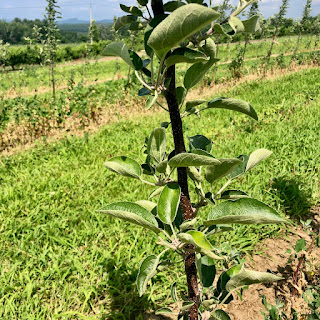Nursery apple trees that arrive as unbranched, so-called “whips” are a perpetual problem. In the old days, when growing a central-leader tree, those whips were simply headed (cut) at waist height and then a lower tier of scaffold branches would result from buds breaking and shoots growing (feathers) vigorously just below the heading cut. Then some of those would have to be “stripped” off so a proper leader could form (http://fruitadvisor.info/tfruit/clements/articles/youngtreetraining.htm).
But if a tall-spindle system is being planted, that heading cut is a big no-no, you don’t want strong vigorous shoots growing that form permanent scaffold branches. Unless the nursery tree comes already feathered, it’s nice to get numerous smaller branches “breaking” along the length of the leader starting at approximately knee height and moving up the leader. What typically happens on whips, however, is only the top buds break going a foot down or so from the top of the leader. In addition to ending up with a top-heavy tree, those shoots will flex their apical dominance and further prevent lower buds from breaking. So, intervention is desired on newly planted whip apple trees to get the uniform branching up and down (to knee height) the tree and create the desired tall-spindle form early and going forward.
Several techniques can be used to induce this kind of branching. A common recommendation is to spray the leader with 6-BenzylAdenine (6-BA) at bud break. 6-BA formulations include Promalin or Maxel (Valent) and Exilis or Perlan (Fine Americas). Over the years, I have found this to not be particularly successful at inducing branching (http://umassfruitnotes.com/v75n3/a3.pdf). Dormant buds along the leader can also be painted with a high concentration of 6-BA in latex paint but this must be done before bud break. It is largely successful but can stunt the growth of the resulting shoots (http://umassfruitnotes.com/v79n3/a2.pdf; http://umassfruitnotes.com/v80n1/a2.pdf; http://umassfruitnotes.com/v85n1/a6.pdf). Notching of the leader just above the bud where a branch break is desired can be effective, however, it is time consuming when using a hack-saw blade as has been often recommended. Recently, I’ve become aware of using a double-edged, anvil-style hand pruner making two opposite side “notches” just above buds in the region where branching is desired (Stefano Musacchi, WSU, personal communication). I have previously tried this here and there and my observation was that it does indeed appear to be quite effective. So, in 2021 I decided to do a mini-experiment to demonstrate this method of inducing branching on whip nursery apple trees.
Methodology was quite simple, I selected 30 just-planted whip apple trees at the UMass Orchard in Belchertown, MA. In a random manner, ten of the trees were NOTCHED using a double-edge hand pruner (STA-FOR Double Cutting Pruner, https://www.oescoinc.com/hand-tools/hand-pruners/double-cutting-pruner.html) just above each bud in the region where branching was desired, i.e. from approximately knee height then upwards about 18 to 24 inches. Typically, eight buds (plus or minus) were thus double-notched. This was done just as the buds in the top of the trees were breaking, but the dormant buds that were notched showed little or no growth (yet). 6-BA in the form of Promalin per the label rate (400 ppm) and directions for promoting branching at bud break was also applied to a similar region of the leader on ten other trees, and ten trees were left alone (the UnTreated Control, UTC).
In mid-June, the number of branch breaks (greater than 2.5 inches in length) on each tree in the region the branching treatments were applied were counted, and the results speak for themself. NOTCHED trees averaged 8.5 “breaks” per tree that are becoming feathers or branches. Nearly every notched bud broke and grew into a feather. 6-BA way underperformed compared to notching, with only 1.9 breaks per tree, and the UTC only resulted in an average of 0.8 branches per tree. (If you insist, a statistical analysis was done on the data, and the difference in branching was significant, and the NOTCHED treatment resulted in significantly more branching than the 6-BA and UTC treatments, which did not significantly differ from each other.)
Clearly notching using this double-edged anvil-style pruner is effective, and making the notches using the pruner is reasonably quick. Care must be taken, however, to not cut all the way through the tree nor to girdle the tree. (Someone suggested angling the pruner a bit to lessen the risk of girdling.) For several hundred newly planted trees that are whips it sure beats getting out the 6-BA filled backpack sprayer or the paint mixed up with 6-BA asNOTCHING in this manner is very effective at making branches. You do of course need to have a viable bud where the notch is made, and it is not alone effective at breaking branches on older “blind” wood without further intervention (http://umassfruitnotes.com/v82n3/a2.pdf). Furthermore, 1st-leaf trees should be planted early, fertilized, and irrigated to get the most out of your notching effort.
Here is a YouTube video about this mini-experiment: https://youtu.be/x2EqTUTBhFc
 |
| NOTCHING just above a dormant bud using a double-blade anvil style pruner |
 | |
| NOTCHING resulted in 8.5 feathered branch breaks per tree |
 | |
| 6-BA application resulted in an average of only 1.9 feathered branch breaks per tree |
 |
| UTC (no intervention) resulted in average of just 0.8 feathered branch breaks per tree |
